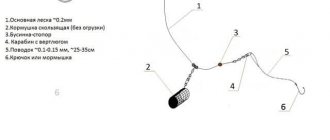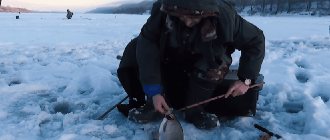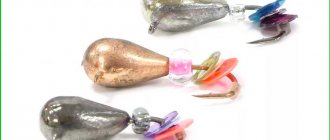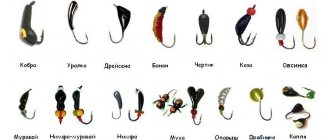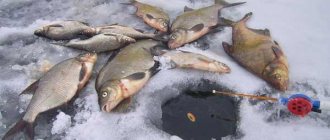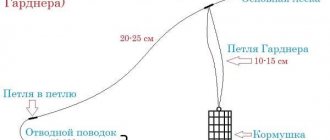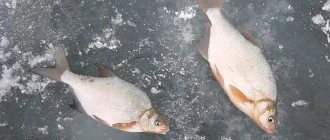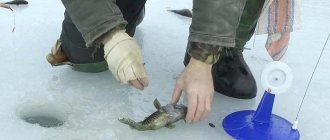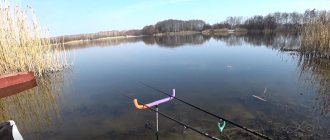Lure fishing in winter. There are many ways to fish from ice in winter. Jig fishing is the most popular, and recently the number of fans of angling predators on girders has increased, but vertical trolling is perhaps the least widespread.
The frozen reservoir is always full of jigs, red flags of the girders can be seen all around, and only a couple of fishermen are trying to shine. But with a good spoon, when used correctly, you can catch much more fish than with a jig.
Advantages and disadvantages of winter fishing
The advantages of this hobby include:
- the ability to fish anywhere in the reservoir, since it is covered with ice and you can get anywhere on foot;
- no need for long-distance casting of gear;
- increased ability to control gear.
Winter fishing has many more disadvantages. These include:
- severe weather conditions;
- limited species composition;
- difficulty in handling gear due to low temperatures;
- the need to use special equipment;
- difficulties in finding fishing spots;
- small working area limited by the drilled hole;
- increased risk of loss of catch associated with hooking an individual much larger than the diameter of the hole.
Features of winter fishing
Winter fishing
- This is fishing that involves anglers going out or going out onto the ice of reservoirs.
It would be more correct to call it ice fishing
.
It is no coincidence that in German this type of fishing is called Eisangeln (literally, Eis means ice and Angeln means fishing). Winter fishing
This is understandable, since in Germany ice in winter is very rare. And without ice, it’s just fishing in open water in cooler times. In our country, the words “winter fishing” mean fishing from ice, so winter in Russia presupposes the presence of this very ice on the reservoir. Although in recent years the expression “winter spinning” has also come into use - a rather exotic type of fishing for us.
Winter fishing is such an exciting activity that a person only needs to visit it once or twice, experience all the delights of this wonderful vacation, and that’s it. Winter fishing is a “disease”, and an incurable one!
How eagerly winter fishing enthusiasts await the start of the next season. In recent years, the weather seems to be specifically testing their nerves. Winter in the central zone comes only in December. And then a holiday comes for winter fishing lovers!
Choosing a site for winter fishing
The choice of place for fishing depends on the following: what kind of fish we need to catch. For example, pike prefers places with grass, and pike perch, in turn, avoids such places, and likes to hide behind heavy snags, stones, etc. So, information about the lifestyle and habits of the fish is not superfluous.
In winter, on ice, you can choose any point in the reservoir as a place for fishing - this is a special advantage of fishing in winter. At the same time, at this time, the underwater world, unfortunately, is closed to the fisherman, and this greatly complicates and complicates the search. Since the warm weather, a true fishing enthusiast has been looking closely at those areas where he is lucky enough to fish on ice. Vegetation in the water, current speed, depth, vector of deflected jets, shallows, rifts, islands, bottom structure (clay, sand, stones, pebbles, boulders) - everything is of interest to him, any information will be used in winter.
In certain places of the reservoir there are thickets of reeds, reeds, and horsetail. Aquatic inhabitants perceive them differently. Reeds can scare fish with their noise, and they almost never enter such places. Reeds are another matter. Among its thickets live pikes, roaches, perches and other fish - some sit out in search of prey, others hide in a safe place.
But the fish are most interested in horsetails. At the beginning of winter days, it often happens that among the thickets of horsetail, which cover large areas of the reservoir, many perches of various sizes accumulate. Horsetails also attract other fish, perhaps due to the fact that the water in such places has special properties due to alkali, and in winter there is more air in such thickets, as it penetrates the hollow stems of the plant and enriches the water. Those fish that have any damage, abrasions, scratches, enter the horsetail thickets as if they were in a hospital. In general, horsetails are a guarantee that there are fish in the reservoir. At the same time, this is a signal to the fisherman about danger, because the ice in the grass area is often less durable than in other places in the reservoir, so you need to approach reeds, horsetails, and various bushes very carefully, checking every step with an ice pick.
Choosing a site for winter fishing
“Piglet” - a relatively shallow place among impressive depths - always attracts fish. Scavengers, perches, and large-sized roaches visit such shallows from time to time; one even wonders how they ended up there. Fishing can be done both directly on the “patch” and on the approaches to it. “Fish trails” really do exist. At some times it is a ditch on an underwater plain, and at other times, on the contrary, it is something like an embankment or shaft that stretches under water in some direction. It happens that such a “path” is guessed by the vegetation, but it also happens that there is no visible vegetation on the bottom, but the fish, nevertheless, do not lose their path and even move along it according to the schedule.
If the hook takes out any greenery from the bottom, the fisherman better inspect it carefully. If it is elodea, then you can leave the hole: as a rule, only small perch and brushes, weighing no more than 20-30 grams, are pecked.
The places where the sandy strip ends and the one covered with pebbles begins are noteworthy; various bugs, larvae, etc. huddle among it - fish of various species can live here. Many fish are also attracted by riffles, just like in the summer. Below the rapids, where the depth begins and sometimes goes into ledges, you can often find large fish. At the border where the reverse and forward flow of water intersect, it is convenient to fish with a small jig: there is no current, but fish, nevertheless, can be found.
Search methods used in an unfamiliar body of water may depend on many factors: the time that can be spent fishing, the size of the reservoir and its depth, what kind of fish is preferable for fishing, the absence or presence of various devices, etc.
What is more advisable: searching for fish or waiting for its approach? This is a personal matter for the fisherman: there is no point in recommending an inspection of a large hole to someone who wants to sit and just relax in the fresh air. Such a fisherman chooses a quiet place for himself, drills several holes, feeds and patiently waits for a bite. It happens that patience is rewarded, and the catch of such a fisherman exceeds the catch of a restless fisherman who has tried many holes over the same period of time.
Drilling more than one hole in a meter of ice without checking the first for the presence of fish is advisable only in situations where there is confidence that the work will not be in vain. This approach requires either good knowledge of the reservoir, or, if the reservoir is unfamiliar, the ability to identify fishing spots based on the external environment.
Carrying out a search with depth measurements, or using any signs (openings, cracks, grass) to determine the location of anomalies in the bottom of the reservoir. And only if such a place is found, it is checked whether there is fish. You can do this in the following ways:
- The first is to quickly go through the holes with search gear, with further clarification of the fishing methods and the gear used, based on the results of the passage. For example, intensified fishing of the selected horizon, where bites are especially active or, on the contrary, searching for other bottom topography.
- The second method is much more reliable, but requires more time, which will be spent on feeding the most successful holes and waiting for the fish to come for feeding. In this case, there is a risk of wasting part or all of the complementary food in vain. So it makes sense to feed only those holes in which the presence of fish is very likely to be guessed.
- A search method in which a fisherman with ready-made gear “runs” after the intended prey is usually called running fishing. At the same time, an impressive number of holes are fished, with short delays at each. This tactic helps in checking a large area, since time is spent only on fishing and drilling a hole.
What kind of fish do you catch in winter?
An experienced fisherman knows well not only what kind of fish bites in winter, but can also tell which species is best caught by month and even by decade.
At the beginning of winter, all the fish are still caught. In open water, fishing with a float in December brings good catches. But in the second half of the month, the fish begin to hibernate, and fishing efficiency decreases.
Predators are well caught: pike perch, burbot, perch, pike, worse - bream, gudgeon, chub, dace. Winter bottom fishing with a feeder is effective in December: you can catch crucian carp, carp, and roach.
Fishing in January brings excellent catches. At this time, fishermen move to the ice; the fish bite well after several days of relatively warm (up to -10°C) windless weather. Pike and pike perch can be caught well with a zherlitsa - sensitive tackle, and bream and perch - with a jig.
At the end of January and the first ten days of February, biting activity dies down, but in the second half of the month, as the day length increases, it becomes more active again. At this time you can catch pike perch, perch, and ruff. Pike are still inactive. By the end of the month, the activity of grayling, trout, bream, ide, roach, and chub increases.
According to the first ice
First ice is a short period of time: 10-12 days from the moment the first frost hits. Fishing during this period is dangerous because the ice is still too thin. But fishermen always look forward to it, because it is one of the most productive biting periods of the year.
On the first ice, the best places for fishing are shallow waters with thickets of reeds, reeds, over flooded snags and stumps; later, when the thickness of the ice increases, you should move closer to the mouths of small rivers and places where springs emerge.
To catch ide you should look for a flat, deep stretch, for perch and pike - places near the cliffs in front of the holes, roach is found closer to open water at a depth of 1.5-2 m.
It should be taken into account that during the first ice, a lot of fish accumulate on the border of light and dark areas, i.e. where the border of transparent and matte ice is clearly visible. Dark ice is a good shelter for fish in case of danger. If the ice is dark along the entire edge, then fish should be looked for closer to open water.
In winter, fish bite on the first ice around the clock, for example, perch comes out to feed in the early morning, when it is still dark, and after 15:00 in the afternoon, burbot - after dark, ruff - at almost any time.
In the wilderness
In the European part of Russia, the wilderness occurs in February. The period received this name for many reasons:
- there is too much snow, so it is difficult to move to the fishing spot;
- short daylight hours;
- due to the large thickness of the ice, it is difficult to drill holes;
- low temperatures do not allow you to stay in one position for a long time;
- fish are least active during this period;
- many gears are useless at this time of year.
However, true lovers of fishing in winter and deep winter hunt for perch, ruffe, bream and roach. The success of fishing during this period largely depends on a good knowledge of the area, methods of fishing in winter, which imply information about how to fish correctly and what to fish for in winter, as well as the endurance and dexterity of the fisherman.
On the last ice
A unique indicator of the onset of the period of last ice is the activation of bleak, which rises from the bottom and begins to actively feed. Following the bleak, pike perch, roach, and bream become active during the thaw.
Fish should be looked for in river beds and stream confluences. However, fishing during this period is associated with many inconveniences:
- the fish becomes too active and unpredictable, which means it’s difficult to find a good fishing spot;
- Frequently changing weather also changes the feeding time of fish, which makes it difficult to find it;
- Most often, a good bite is observed where the ice has become very thin, which is unsafe;
- The search for fish is hampered by unevenly melting ice.
The Dangers of Ice Fishing
Dangers of winter fishing Winter fishing also involves the need to take a number of precautions to avoid falling through the ice.
Swimming in cold water is fraught with all sorts of consequences and is dangerous not only for health, but sometimes for life. The fisherman should be especially careful on the young, still thin, first ice and on the thick, already loose last ice, at the end of winter - beginning of spring. Autumn ice is stronger than spring ice, but you should not go out on it before the thickness reaches 5-6 cm. You must have skis, but you cannot tie them to your feet. The fastenings must be such that, if necessary, the skis can be easily reset. It is recommended to follow the trail. It is imperative to inspect and probe with an ice pick the places near grass, bushes, hummocks, snags, etc. sticking out of the water. Here the ice is often very weak. During the first ice and at the end of winter they do not go fishing alone.
If you still fall through the ice. The main thing is not to panic and try to throw off heavy things - a drill, a box. Then you need to rest against the edges of the ice with your hands or a stick, turn flat and crawl onto the ice. You need to get out in the direction from which you came. Once you are out of the water, you should never stop until you get to a warm place to warm up! You should also change clothes as soon as possible.
You cannot hesitate to help someone who has failed. But you need to approach it very carefully. It’s better to crawl up and give a pole or throw a rope. Groups may not gather on either the first or last ice. Fishing should be done intelligently, without unnecessary risk.
To get out on the ice on your own, a winter angler must always wear a self-rescue kit in the form of a rope and hand grips that will allow you to cling to the ice with frozen hands.
Do you need bait, and how to improve the bite?
For winter fishing to be successful, you cannot do without feeding. Perch, bleak, and bream immediately react to the appearance of food, and after a while predators flock to them as bait: pike, pike perch. But it is also possible to carry out targeted feeding of predatory fish using chopped worms or bloodworms.
Organizing complementary feeding of fish in winter is quite complicated, as it requires taking into account many factors:
- feed viscosity, which depends on the depth of complementary foods and the presence of current;
- colors (it must match the color of the bottom);
- method of delivery to the water (without additional devices, using a feeder-dump truck or a stationary feeder).
The component composition of the feed mixture depends on the type of fish and reservoir:
- in stagnant waters, the main ingredient of the bait should be bloodworms;
- On the river and on the reservoir near the shore, bloodworms work well, and at depth - jigs;
- on old river beds, chopped worms should be added to the bait mixture.
However, bait tactics are always approximately the same:
- For complementary feeding, several holes are prepared and the feed mixture is poured into each.
- You should fish each hole one by one to find out where the fish have gathered.
- Feed should be periodically added to the holes in which a bite is detected.
Techniques for catching white fish
Fishing in the current is quite easy. With some experience, the flow of water has a positive effect on the equipment, further stimulating the fish to bite. As a rule, no ornate wiring is carried out on the river.
The main animation techniques are:
- tapping on the bottom;
- stirring at the bottom;
- smooth swaying;
- a leisurely monotonous rise and subsequent descent of the bait.
For winter fishing of bream with a feeder, no wiring is required at all. The equipment is installed at the bottom by using a sinker of the required weight. The hook is located above the load and moves due to the force of the current.
Regardless of fishing methods, the bite in the current is always confident. The fish does not behave as carefully as in “still” reservoirs, because it is afraid of losing its prey. Therefore, idle contacts are rare, even when fishing for fastidious roach.
Fishing in a current is a little more difficult than in a standstill, all due to the same presence of current. The flow of water increases the resistance of the fish caught on the hook and makes it difficult to insert the equipment into the hole vertically. In this situation, you should never rush, trying to bring your prey to the ice as slowly and carefully as possible.
Lures: what to fish with in winter
Lures for fishing in winter are divided into natural and artificial.
Natural
Natural varieties of bait include:
- Bloodworm is a mosquito larva that is good for catching most types of fish. Bait does not last long.
- Maggot is a fly larva with a longer shelf life. It is good for catching crucian carp, perch, and roach.
- Codling moth larvae that live in apples and have a pleasant smell. White fish bite on them.
- Bark beetle larvae, which are also eaten by white fish.
- Worms. They are effective for catching predators in winter, such as perch and pike perch.
- Mormysha is an amphipod crustacean, which is a rare but effective bait for catching both peaceful fish and predators.
Artificial
According to fishermen, when fishing with jigs, winter fishing brings the most catch. However, there are other equally effective methods of winter fishing, for example, with a balance beam, with a “devil”, or with “eggs”. It bites well on a spinner in winter.
All these baits have many varieties, differing in appearance, shape, size, color, weight and method of fishing with them. The choice of bait depends on the preferences and experience of the fisherman.
Features of lure fishing
There are only two main reasons for the low interest in winter lures. Firstly, not always and not every predator can be interested in a spinner. Secondly, the variety of baits in this category leaves much to be desired. From the meager arsenal offered in fishing stores, it is difficult to choose truly catchy winter lures. For example, the high efficiency of the vaunted Swedish baits with a chain on many reservoirs in the middle zone of our country turned out to be doubtful. That is why, in order to successfully lure, many winter fishermen have to turn to artisans or make working lures themselves.
Some fishermen lack persistence and endurance. It's not just about bait. It’s not enough to have catchy lures; you also need to be able to look for fish, use various tactics that allow you to get a couple of “tails” even in the midst of the wilderness. Many beginners who tried to shine and did not see a single bite (the one that could become a powerful incentive) quickly return to jigs.
Meanwhile, lure fishing is no less exciting, exciting and rewarding than jig fishing. And under certain conditions it is even more effective. You just need to adapt to this method of ice fishing, learn to notice seemingly insignificant little things, learn to see and correct your mistakes, do everything correctly and consistently. Only with this approach does winter flashing become an exciting activity.
The most necessary accessories for winter fishing
To make fishing in the cold a pleasure, you need to take care of clothes and shoes, which are the most important accessories for winter fishing. The most comfortable types of outerwear are a short fur coat or a quilted padded jacket.
They should be worn over a wool turtleneck sweater. If it is snowing, you can protect yourself from it with a rubberized raincoat or a canvas raincoat with a hood.
It is equally important to properly insulate your feet. Felt boots with high galoshes are best suited. You can use rubberized boots several sizes larger, and put 2-3 pairs of woolen socks or a pair of fur socks on your feet. Hands are protected with fur mittens.
Other important accessories include:
- a tent that protects from the wind and allows you to stay in the cold longer;
- a box for winter fishing, in which they store fish, fishing supplies and essentials (first aid kit, thermos with hot tea) and sit while fishing;
- ice ax;
- a scoop for clearing the hole of snow and pieces of ice;
- a hook for pulling fish out of a hole (a fish cage cannot be used to pull fish out of a hole);
- electronic bite alarm - a device that gives sound and light signals when the nod oscillates, helping to hook fish in time;
- depth gauge;
- jackknife.
Ice fishing equipment
Accessories
Accessories for winter fishing Preparation for winter fishing is carried out more carefully than for summer fishing.
Therefore, it will simply be impossible to do without some accessories. For example, in frosty winter the hole constantly freezes, and is also periodically covered with snow. To prevent snow and pieces of ice from interfering with fishing, they must be regularly removed from the hole. You can do this with a handful, but for greater convenience it is worth using a scoop - a special accessory designed to clear the already small space of the hole from various interfering objects, such as snow or ice.
In winter fishing, ice fishing is often accompanied by situations where a catchy spoon or jig gets caught on something on the bottom. If you can’t quickly release the tackle, an accessory called a release can come to the rescue. It is attached to the fishing line and helps to quickly release your favorite tackle, avoiding its loss.
A special accessory for winter fishing is a fishing box. This is generally an indispensable accessory for winter fishing, because it simultaneously performs several functions: a comfortable stool, a place to store various fishing gear and a place to store food and drink.
In general, winter fishing is impossible without such an accessory as a fishing drill for ice - an ice auger. Since ancient times, an ice pick has been used to cut holes, but this old-fashioned method has long been outdated, since it is quite labor-intensive and also scares away the fish. Modern fishermen widely use auger ice screws, which have proven themselves well and have stood the test of time. With the help of such ice drills you can not only cut ice perfectly, but also immediately remove ice crumbs from the hole. Recently, motorized drills powered by batteries or gasoline have become increasingly popular.
In addition to the already described accessories used by fishermen, there are others that are characteristic of different areas. There are many of them, and they all help simplify and make life easier for fishermen. Most often, fishermen use:
A fish scaler is an accessory for cleaning fish. A kitchen or regular camping knife is not suitable for cleaning fresh fish, so craftsmen came up with such a special accessory. A fish scaler helps make the process of cleaning fish easier and shorter in time.
Extractor - a device for removing a fishing hook from the throat of a fish. It allows you not to damage the fish itself, and also not to break the tackle.
A gapper is a spring-based device that allows you to keep the mouth of a predatory fish open while removing the tackle.
Leskovdevatel – an accessory whose name already says it all. With its help, the fishing line is threaded through the narrow holes of gear and hooks, and the whole process takes much less time thanks to this wonderful device.
Bait containers - wooden boxes used by many fishermen to store animal baits - worms, bloodworms, jigs, caddis fly larvae, etc. With the help of such drawers, the nozzles are protected from heating in summer and from cooling in winter. Lids must have holes for air. Plastic models are more practical, but in winter they protect the nozzles from the cold worse than wooden ones.
A wind shield is the simplest shelter for winter fishing that serves as protection from the wind. It is a structure of three slats, which are covered with light fabric. Using a pick or an ice drill, holes are made in the ice into which the ends of the slats are inserted. A more practical version of such protection, used by some fishermen, is a tent with a cut-out bottom.
In addition, fishermen use other accessories: steelyards for weighing the catch, spoons for casting, bait, beads, anchors, compasses, thermoses, flashlights, binoculars.
Equipment
Lingerie
Equipment for winter fishing In the autumn-winter period, when the weather is low in temperature, you should give preference to flannel or woolen underwear. It is worn directly on the naked body, as it allows evaporation to pass through, and therefore dries quickly. If woolen underwear causes skin irritation, you should wear thin cotton underneath. For those suffering from radiculitis, it is recommended to use special therapeutic chlorine underwear. Recently, thermal underwear has become increasingly popular.
Socks
Experienced fishermen prefer to choose wool socks, which retain warmth even after getting wet. Sometimes fur stockings can be an excellent replacement for wool socks. They are indispensable if rubber boots are often worn. In addition, fur stockings make it easy to put on and take off boots, especially if you wear nylon women's stockings on top.
Outerwear
The fisherman's outerwear should be light, durable, waterproof, heat- and cold-resistant, and does not interfere with the evaporation of moisture from the surface of the body, that is, “breathable.”
It is better to avoid long fur coats due to their heaviness. Preference should be given to a more comfortable light tanned sheepskin coat with long sleeves and a fur collar. The length of the short fur coat should not be much above the knees, it should be loose at the shoulders and chest, and the sleeve length should reach almost to the tips of the thumbs, but so that if necessary, the edges can be tucked. A short fur coat is chosen for its comfort and good heat retention, as well as for freedom of movement. However, if it gets wet, it should be dried carefully at some distance from the fire.
If you are seriously interested in fishing, you should also take the choice of outerwear seriously. Experienced fishermen prefer branded equipment designed specifically for any fishing conditions. Many companies develop outerwear for fishermen.
There are even special overalls that can serve as a life jacket in certain circumstances. This overalls can hold a person weighing up to 100 kg on the water thanks to a special gasket and a special insulating layer inside.
Shoes
For winter fishing, many anglers choose handmade felt boots. They are distinguished by their softness, lightness and excellent ability to retain heat. However, it is better not to wear such felt boots without high galoshes. Yes, and the galoshes will have to be glued from soft rubber so that they fit tightly.
Choosing ordinary small galoshes is not advisable, since snow quickly fills them and they fall off easily. In general, you can’t do without galoshes, otherwise your felt boots will quickly get wet on wet ice. They can only be replaced with shoe covers made of waterproof fabric, but in this case it will be inconvenient to move around. Replacing galoshes with shoe covers only makes sense when fishing without significant movements.
Some fishermen make their own winter stockings, allowing their felt boots to become waterproof.
More comfortable polar boots can replace felt boots. They consist of two layers of rubber separated by a layer of wool fabric. These boots allow you to fish from ice in 30°C frost. They are not afraid of water coming out from under the snow on the ice. Polar boots have a significant advantage over felt boots.
Mittens
One of the main conditions for successful fishing is sensitive hands, so even in severe frost it is very important to maintain contact with the tackle.
You can achieve complete preservation of hand freedom, including finger movements, by using woolen wristbands that cover the wrist and half of the hand, or by using cotton gloves with the thumb and forefinger cut off in half. It is precisely because in winter they allow you to easily attach bloodworms and catch them with a jig. But in any case, you need to be very careful not to freeze your fingers, because this is very easy to do.
Some fishermen refuse mittens altogether, especially knitted gloves with cut off fingertips: they do not retain heat well, and also get wet quickly, especially during intensive fishing. The choice of experienced fishermen are mittens that fall freely from the hands with the slightest shaking of the hands. To prevent them from falling into the snow, they are fastened together using a long braid hung around the neck under the collar. For winter fishing you need warm mittens, so they are made from fluffy hare, fox or wolf fur, covered with cloth or soft dense fabric on top. Canvas mittens are used less often: they are less comfortable, as they restrict movement, but they are durable and dry quickly. In mild frosts, you can use cotton or leather gloves to allow your hands to remain mobile.
Neoprene gloves are more comfortable. They have very good durability and water resistance thanks to the rubberized outer layer.
Law
The Federal Law “On Fisheries and Conservation of Aquatic Biological Resources” dated December 20, 2004 is in force throughout the Russian Federation, which prescribes:
- basic rules of fishing (sports and amateur);
- measures aimed at preserving the country's biological resources;
- rights and responsibilities of fishermen;
- penalties for violations of fishing conditions.
However, in each region there are also regional and regional laws on fishing, taking into account local climatic conditions and the biodiversity of aquatic fauna. These laws impose restrictions and prohibitions on fishing periods, methods and places of fishing, and set catch limits. An angler should be guided by these laws when going fishing.
What are the prohibitions on winter fishing?
General fishing bans that apply in all regions of the country all year round include the following:
- Bans on fishing on an industrial scale without a license.
- Bans on fishing in nature reserves, fish hatcheries, fish farms, near bridges, locks, and dams.
- Bans on fishing based on the length of the fish. An individual should be released if its length is less than the established dimensions, for example, pike perch if its length is less than 38 cm, burbot - less than 40 cm, pike - less than 32 cm, carp - less than 24 cm.
- Ban on fishing by quantity:
- gudgeon, ruffe and bleak can be caught in any quantity;
- fishing for fish species included in the federal or regional Red Book is completely prohibited;
- the catch rate per person is no more than 5 kg of fish;
- catching fish for bait should not exceed 30 fish per day.
- In winter, it is prohibited to fish in pits in which fish accumulate for the winter.
Burbot. Fishing with bait
Fishing for burbot in winter on a small river can also be very productive. Fishing with winter girders is quite naturally combined with fishing with the simplest bottom gear - set-ups. In busy areas where there are quite a lot of anglers, these rigs are more suitable for being left unattended overnight. These gears are not so sorry, unlike the girders, if people who are not very burdened with conscience get to them. And the bait consists only of a sinker, the main fishing line, one or two leashes with large single hooks.
It is better to make one of the leashes metal and put a live fish on the hook. The metal leash serves to resist the grip of the pike, which can also grab from the bottom, where live bait usually sinks to catch burbot. The second short leash can be tied directly to the main leash, about 30 centimeters long, ending with a metal leash.
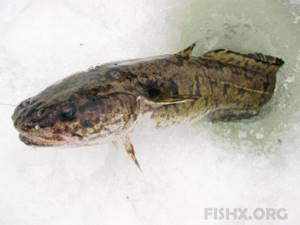
Cut fish are most often placed on the hook of the second leash: roach, ruffe, gudgeon and other small fish. Worms are also used, which are planted with large brushes. But the disadvantage of such bait is that the worms are sucked on by various bottom trifles. And the bait is often not saved until the burbot comes out. In addition, small and medium-sized burbots are mainly caught on worms.
There are often difficulties in catching small fish. And here you can try using fresh sprat purchased at a fishing store or even in the fish department of a regular store. Burbot often bites on sprat, especially on the Volga.
Share with your friends!
Lifehacks
Fishing requires ingenuity and ingenuity from the fisherman, especially if fishing occurs in winter, which has the most difficult conditions.
How to prevent the hole from freezing?
Setting up a tent or snow wall can help keep the hole from freezing. However, if there are several holes, then you cannot put a tent on each one.
To prevent the holes from freezing, you can do the following:
- drop 1-2 drops of vegetable oil into each of them;
- prepare circles from linoleum or dense polyethylene and cover the holes with them, and punch a hole in the center of each for the fishing line;
- Take old buckets from home without a bottom and place them in the hole.
Illumination of holes for winter fishing
When fishing in January, when daylight hours are as short as possible, you can use backlighting to lure fish to the hole. It is easy to make with your own hands using available materials.
You need to take a simple battery-powered flashlight and wrap it in several layers of cling film (it does not allow water to pass through), then treat the unscrewing parts with silicone, attach a fishing line, and the light is ready.
If necessary, it can be made heavier. You should not place both a flashlight and a fishing rod in the same hole, as the fishing lines can get tangled. A separate hole should be drilled for the lantern.
How to darken a hole during winter fishing?
Darkening the hole is an important condition for productive fishing. From below, the fish sees the hole as a bright spot, and if it is darkened from time to time by the shadow of the fisherman or the fish he pulls out of the hole, the rest of the fish will perceive this as a danger and leave for a long time.
To prevent this from happening, experienced fishermen always darken the hole using circles made of plywood, linoleum, thick cardboard, or rubber. If you don’t have any of this at hand, you can simply fill the hole with snow by making a hole in the center for the fishing line.
In the process of landing fish, it is better not to remove the cover of the hole, but only bend it back.
Winter fishing in the cold
The largest fish bite in winter at the lowest temperatures. For this reason, many fishermen flock to reservoirs at temperatures below −15…−20°C. However, fishing in such frost is associated with health hazards and problems with equipment.
In order not to get sick, it is necessary not only to choose the right clothes and equipment, but also to develop a clear plan of behavior and fishing tactics:
- Fishing must take place in active mode, i.e. you cannot sit - you must constantly move.
- You can fish in this weather with a spinner and a baitless jig. Fishing at low temperatures is also possible with a float rod, but only if you have a tent and additional heating.
- You can only warm up with hot tea: alcoholic drinks warm you only for the first 15 minutes, and then a second dose is required.
- At the first signs of freezing, fishing should be stopped immediately.
- At low temperatures, plastic skimmers are not suitable for removing snow and ice from the hole: they cannot handle the ice and break. Skimmers should be made of metal with a sharp edge and a foam handle.
How to drill holes correctly?
To properly drill an ice hole for winter fishing, you need to:
- When drilling a hole, throw the ice in the direction from which the wind is blowing, and the opposite side should remain clean. A fishing rod is attached to the resulting mound of snow and ice above the hole.
- If the ice is too thick, drill in several passes.
- Do not remove snow from the hole, as it produces excellent shading.
- Drill adjacent holes at a distance of at least 0.5 m from each other to avoid tangling gear under the ice.
After finishing work, the ice ax should not be left in the cold. It is better to drill a separate hole for the device and place it in a vertical position.
Tackle for winter fishing
Winter fishing
traditionally loved in Russia. During the winter frosts, the ice of almost every body of water is covered with figures of fishermen who do not leave their shelter until dark in an effort to catch a large fish. Many people point out that it is impossible to use ordinary fishing rods for such fishing; their length of several meters is completely unsuitable for ice fishing. We need a different fishing technology and different gear. And even other bait, and other methods of bait. Any good fishing store will offer fishing fans comfortable gear, a huge selection of winter lures, and a catalog of wobblers, where you can choose everything you need for successful ice fishing.
Fishing rod for winter jig fishing
Balalaika There are many options for fishing rods for jig fishing, including lightweight ones. The most famous fishing rod is called the balalaika, as it is very similar in appearance to this musical instrument. A fishing rod for fishing with a jig should be selected based on its ease of placement in the hand, lightness, and material. The material of the fishing rod must be non-thermal conductive, since fishing with a jig often occurs when holding the tackle with your bare hand.
Fishing rod
Usually it looks like a short light whip no more than 200 mm long. Amateur fishing rods, as a rule, have a massive design that does not allow winter drifting snow to carry them away if the fisherman places the tackle near the hole. The fishing rod usually has supports for mounting on the ice. Most often they are made in the form of thin plastic flyers, although other lightweight material can be used.
fishing line
For this gear, you need to choose fishing lines that are as thin as for a winter float fishing rod. If you plan to fish for large predatory fish, then the cross-section of the fishing line can be increased, but you should remember that this will lead to a deterioration in the performance of the jig.
Nod
For its manufacture the following can be used:
- wild boar bristles;
- plastic;
- spring steel;
- rubber, etc.
Its main property is the ability to subtly respond to the slightest movements of the fishing line in any frost. It can be replaceable or adjustable. Its task is not only to signal when a fish is biting, but also to ensure that the bait plays.
Mormyshka
It is an indispensable attribute of a winter fishing rod with a nod. The imagination of fishermen has invented many forms and names: “ovsinka”, “pellet”, “droplet”, “Ural”, “plate”, “nymph”, “dreissena”, various “witches”, “devils” and many others. At the moment, the development of this universal bait is proceeding in several directions, but two main ones can be distinguished: in some cases, the jig works with an attachment, in others - without it. Each direction has its own fishing technique and tactics.
Float rod for winter fishing
Winter fishing with a float A winter float fishing rod does not need a long rod, since it is only needed to hook a pecked fish and weaken its first impulses when fishing.
And for this, a short fishing rod is also suitable, quite elastic and flexible, from 30 to 40 cm long. A modern winter fishing rod has a thin and flexible whip, conical in shape, and a small hollow handle. Its design can be solid or collapsible.
Vinyl plastic, bamboo or juniper are used to make the whip, and wood, cork, plastic or foam is used to make the handle. Fishing rods are foldable, which is very convenient for carrying. They are made from aluminum tubes and plastic, equipped with a cork handle.
The fishing rod should be different:
- strength;
- ease;
- elasticity;
- flexibility when hooking fish, but not excessive.
The reels are attached to the fishing rod, and there is a loop on the top that allows you to secure the line while fishing.
Lines for winter fishing rods must meet high requirements. When preparing for fishing, you need to choose the forest:
- thin,
- unnoticeable;
- durable;
- having no nodes.
For winter fishing you need a lightweight, easily visible in the water and highly sensitive float. Winter floats usually have a well-streamlined cone-shaped or cylindrical shape. To make them, cork, plastic, tree bark, and pieces of goose feather are used. The colors for painting them are chosen to be bright, contrasting, and applied in transverse rings along the entire length. When fishing, the float should be upside down with its flat base.
The size of this tackle is chosen depending on the fishing conditions: for calm waters - a small float, for rapids - a larger one.
Winter fishing rod
Winter fishing rod for trolling A winter fishing rod for trolling is chosen depending on the height of the fisherman, but within the range of 50-70 cm. Tackle intended for winter trolling is essentially no different from summer fishing.
Some anglers use a regular short spinning rod for winter fishing. A winter fishing rod for trolling can be divided into four main components: rod, reel, spoon and line.
For winter predator fishing, choose the same strong fishing rod as for summer fishing. In addition, it should be light in weight, and also equipped with a good, easy-to-run reel that holds a sufficient supply of fishing line.
When choosing a fishing rod for winter fishing, you should remember about guide rings. The winter version usually contains no more than three. Due to the rather large load when trolling, high demands are placed on the quality of the guide rings.
The reel is almost never used in this type of fishing; its task is to store the fishing line.
The fishing line for catching predators is durable and of high quality. For winter fishing you need very little, 30 meters is usually enough. You shouldn’t skimp when buying it, because the winnings can be quite significant. Choosing a high-quality fishing line allows you to reduce its thickness by at least 0.1 mm. The basic rule for choosing a fishing line: the diameter is selected in accordance with the weight of the spoon so that it easily pulls the fishing line without leaving bends or rings. In winter, it is worth abandoning braids, as they quickly lose their plasticity due to freezing.
The most important part of a winter fishing rod for trolling is the spoon. Its quality is determined by several conditions:
- its shape should allow it to imitate the movements of live bait when playing, provoking the predator to attack;
- its color should be attractive, visible from a great distance;
- its size should correspond to the size of the prey.
Depending on the size of the spinners, there is some general classification. Spinners are divided into:
- Small - from 20 to 30 millimeters;
- Medium - from 30 to 50 millimeters;
- Large ones - from 50 to 90 millimeters.
Depending on the weight, the spoon is divided into light, medium and heavy. The nature of the game of spinners allows them to be divided into diving, oscillating and falling. In the water, the spoon behaves differently depending on its shape and balance.
Perch, pike perch, pike and chub are caught with a winter fishing rod; on northern rivers, grayling and some other species of fish are caught.
Zherlitsy
Classic winter vest
Winter girder To make a stand for a winter girder, use an aluminum corner or tubes.
To make a spool holder, a bicycle spoke or the same corner is suitable. All bends are made rectangular. You can make your own reel from foam or wood, or purchase a factory-made one. It should be 5-10 cm in diameter and 1-3 cm thick. Half of the reel of the winter fishing line should be painted, this will allow you to notice the winding of the fishing line, as well as catch a predator in time.
To make a winter guardhouse, springy steel wire is used. Its lower end is bent so that it can be inserted into the hole located at the bottom of the rack. The upper curved end should securely lock the reel, preventing it from triggering falsely due to jerking of the baitfish.
To make a winter flag, a waterproof synthetic fabric with preferably melted edges is used. The flag can be sewn to the gatehouse or glued with waterproof glue.
When fishing, the girder stand is fixed in the ice crumbs left after drilling a hole. In frosty weather, water is poured over the crumbs to set the ice. It will securely secure the winter rack.
Having planted the bait, the fishing line is unwound into the hole to the required depth. The guard of the girder is wound by a reel. A bite from a predator will lead to the fishing line being reeled in, which means the guard will be thrown off. This moment should not be missed!
This option for making a winter girder has a drawback - it is not very reliable in the ice crumbs. A predator can pull out the entire fishing line and, due to poor fastening, pull the girder into the hole, so it is better to fasten the girder stand in a hole made using a brace with a drill of a suitable size. In addition, such a winter hole allows the hole to freeze, so it has to be covered with snow.
Another type of winter zherlitsa
The base of this winter ice rack is a foam plastic (necessarily made of hard material) or plywood circle with a diameter of 20 cm. The size must be selected so that it is 5 cm larger than the diameter of the ice screw. We make the coil similarly to the previous version. A bolt can be used to secure the coil.
A guard is attached to the base of the vent with a self-tapping screw. The self-tapping screw should have a wide head, for example, like a “bug” for metal profiles. In the case of a foam base, the self-tapping screw should be lubricated with glue. To make a winter guardhouse, you can use spring wire or a similar material. When transporting, the guard is placed along the base of the trap; when catching a predator, it is wound by the reel.
A hole 5-6 mm in diameter is made in the center of the base of the girder, which is connected to the edge of the base with a cut for winding the fishing line.
The difference between a winter girder of this manufacturing method and the previous one is the elimination of cases of fishing gear falling through the ice. In addition, thanks to the base, the hole is protected from freezing. The advantage of this version of the winter girder is the simplicity and speed of installation, because there is no assembly and disassembly stage. A minor drawback is that the line is bent at a right angle in the center of the base, which can make it somewhat difficult to unwind.
Fishing rods for fishing in the current
To make winter fishing on the river productive, you need to properly assemble your fishing rod. Despite the simplicity and primitiveness of some models, there are certain nuances in the equipment.
- Fishermen actively use jig rods. You can catch any peaceful fish, only the equipment of the winter fishing rod for fishing in the current is special. A fishing rod with a nod can be used either purchased or homemade. It is usually equipped with a reel or reel. The fishing line is selected taking into account the size of the fish, the strength of the current and the depth. Typically, the range of monofilament lines is in the range of 0.1-0.2 mm. To choose a jig, you should remember a simple rule.
It is important! The stronger the current and the deeper the river, the heavier and more compact the jig should be. Tungsten baits are optimal.
- One of the types of bottom gear for fishing on a river in winter is a pull-up or pull-up. It has proven itself to be excellent when catching bream in the dead of winter. Assembling the fishing rod begins by installing it on the rod with the reel guides. About 50-70 m of 0.20-0.25 mm fishing line is wound onto the drum. A sliding sinker weighing 10-20 g is installed on the fishing line and secured with a silicone stopper. A carabiner is attached to the end of the fishing line, which is needed to quickly attach the leash. It is made from monofilament 0.14-0.16 mm long, 1.0-1.3 m. A small pellet (1-2 g) is mounted on a leash 20 cm from the carabiner. Before tying hook No. 12-14, a bright bead is attached to the leading line. The shank of the hook is decorated with red cambric.

Photo 2. The fishing rod is equipped with a bright nod, noticeable in the snow.
Attention! A jig can be used instead of a hook. In this case, the pellet is not placed on a leash.
- Catching a predator is still relevant with tackle for vertical trolling. This winter fishing rod is made with your own hands for fishing in the current; it is not very different from similar gear for standing reservoirs, only the mass of bait must correspond to the strength of the current.
- Zherlitsa are also actively used on rivers in winter; there is some difference from the same fishing rods for lakes only in the equipment.
- The winter feeder for ice fishing looks much simpler than the summer version. The rod is selected with a whip 20-25 cm long. It must be equipped with legs and a bright nod. A 0.20-0.22 mm monofilament is wound onto the reel, a small feeder and a leash made of 0.12-0.14 mm fishing line are installed on the base. The size of the hook depends on the bait and the size of the fish; models No. 10-14 are quite suitable.
